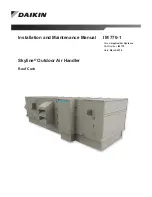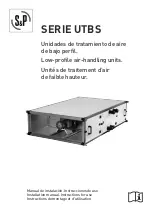
TCF Termoventilatori Condizionatori Felsinea Srl
40057 Cadriano di Granarolo Emilia (Bologna), via Giuseppe di Vittorio 5
www.tcf.it
2
0.
INTRODUCTION
This manual has been compiled by TCF Srl to provide the
installer, customer and user with instructions intended to
ensure the proper management and use of the air-exhaust
units series CV, CVM, CVMI, EV from the delivery up to the
commissioning.
The recommendations which follow are intended to ensure a
continuous and durative operating life of the air exhaust unit.
The procedures described below should be performed by
skilled personnel with a good knowledge of air-conditioning
systems design and operation, even though, thanks to the
unit’s simplicity of design, these could be carried out also by
those unfamiliar with air handling.
1.
DESCRIPTION OF THE AIR-EXHAUST UNIT
1.1
COMPOSITION
The air exhaust unit is made up from:
•
Return section possibly including one control
damper or grille
•
Fan section
1.2
PERMITTED USE
TCF air exhaust units are designed exclusively for CIVIL AND
INDUSTRIAL AIR TREATMENT.
In case of CORROSIVE and/or EXPLOSIVE air flows, a number
of special technical modifications must be made at the design
stage which, altogether, adapt the machine for the treatment
of special air flows.
The air exhaust units must at all times be used strictly in
accordance with the design conditions established at the time
of contract in agreement with the customer. ANY OTHER USE
SHALL CONSTITUTE IMPROPER USE AND IS THEREFORE
DANGEROUS. THE MANUFACTURER MAY NOT BE HELD
LIABLE FOR DAMAGE CAUSED BY NON-STANDARD USE OR
ANY USE NOT ENVISAGED IN THE CONTRACT.
2.
CONTROL, PACKING, TRANSPORTATION
2.1
FACTORY INSPECTION OF THE SUPPLY
Prior to shipping, each TCF air exhaust unit is subject to all
the functional tests listed on the attached UNIT INSPECTION
SHEET. The controls concern:
•
General machine dimensions
•
Correct assembly of the various parts and sections
•
Compliance with the various safety rules in force
•
Integrity of all the system’s component parts
•
Application of the identification, operation and
safety notices
On completion of the inspection, the Chief Inspector applies
the EC mark demonstrating product compliance with
prevailing European Union machine directives.
2.2
PACKING
Transportation of the machines may be:
-
normal
-
special
In the former case, TCF Srl does not normally pack the units.
In case of special transportation, the packing requested is
agreed at the time of contract and is entirely on the
customer’s charge.
Fragile components supplied separate from the unit, such as
control boards etc., are always delivered packed.
2.3
LOADING,TRANSPORT,UNLOADING
TCF Srl disclaims any liability for damage occurred to the air
exhaust unit during loading, unloading and transportation.
We therefore recommend that precautions be taken,
including:
-
The load must be firmly secured to ensure its
integrity during transportation
-
Handling must be performed without exerting force
on protruding accessories (hydraulic attachments,
handles, hinges, air locks, protection roof)
-
Do not overturn the sections as you may otherwise
break internal supports, components and dampers
-
Do not subject the unit to violent impacts as you
may damage its integrity
-
If a forklift truck is used during the loading,
unloading and handling operations, the forks of the
truck must be at least the same length as the unit to
ensure stability (fig. 1)
-
If the air exhaust unit is fitted with a continuous
steel base frame, handling may be carried out with a
crane, using cables firmly secured to rods (sufficient
for the stress involved) passing through the holes
provided in the base.
If a crane is used, proceed as shown in the illustration,
using spacers to protect the structure (fig. 2).
-
During transportation, protect the unit from
atmospheric agents. Special care must be taken if
the unit is supplied disassembled or designed for
internal use.



















